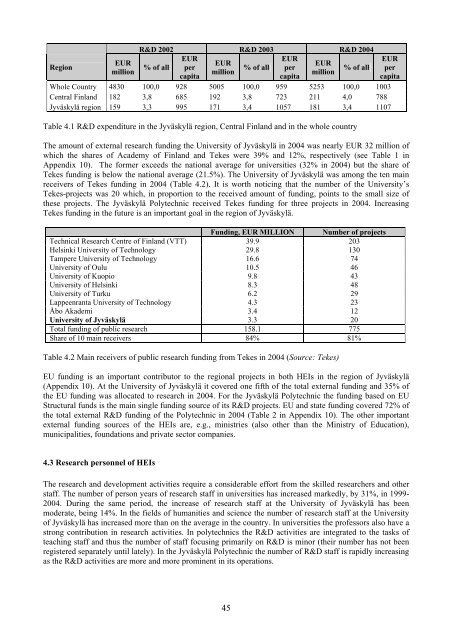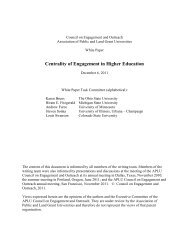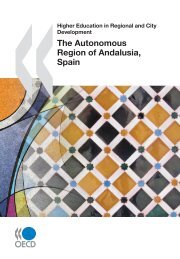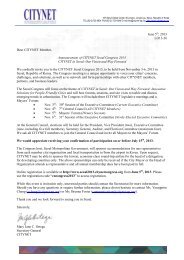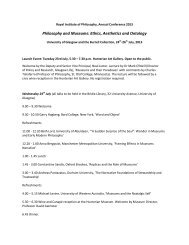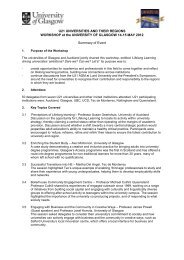Finland - Jyvaskyla Region - Final Self-Evaluation Report.pdf
Finland - Jyvaskyla Region - Final Self-Evaluation Report.pdf
Finland - Jyvaskyla Region - Final Self-Evaluation Report.pdf
You also want an ePaper? Increase the reach of your titles
YUMPU automatically turns print PDFs into web optimized ePapers that Google loves.
<strong>Region</strong>EURmillionR&D 2002 R&D 2003 R&D 2004% of allEUREUREUREURper% of all permillionmillioncapitacapita% of allWhole Country 4830 100,0 928 5005 100,0 959 5253 100,0 1003Central <strong>Finland</strong> 182 3,8 685 192 3,8 723 211 4,0 788Jyväskylä region 159 3,3 995 171 3,4 1057 181 3,4 1107Table 4.1 R&D expenditure in the Jyväskylä region, Central <strong>Finland</strong> and in the whole countryEURpercapitaThe amount of external research funding the University of Jyväskylä in 2004 was nearly EUR 32 million ofwhich the shares of Academy of <strong>Finland</strong> and Tekes were 39% and 12%, respectively (see Table 1 inAppendix 10). The former exceeds the national average for universities (32% in 2004) but the share ofTekes funding is below the national average (21.5%). The University of Jyväskylä was among the ten mainreceivers of Tekes funding in 2004 (Table 4.2). It is worth noticing that the number of the University’sTekes-projects was 20 which, in proportion to the received amount of funding, points to the small size ofthese projects. The Jyväskylä Polytechnic received Tekes funding for three projects in 2004. IncreasingTekes funding in the future is an important goal in the region of Jyväskylä.Funding, EUR MILLION Number of projectsTechnical Research Centre of <strong>Finland</strong> (VTT) 39.9 203Helsinki University of Technology 29.8 130Tampere University of Technology 16.6 74University of Oulu 10.5 46University of Kuopio 9.8 43University of Helsinki 8.3 48University of Turku 6.2 29Lappeenranta University of Technology 4.3 23Åbo Akademi 3.4 12University of Jyväskylä 3.3 20Total funding of public research 158.1 775Share of 10 main receivers 84% 81%Table 4.2 Main receivers of public research funding from Tekes in 2004 (Source: Tekes)EU funding is an important contributor to the regional projects in both HEIs in the region of Jyväskylä(Appendix 10). At the University of Jyväskylä it covered one fifth of the total external funding and 35% ofthe EU funding was allocated to research in 2004. For the Jyväskylä Polytechnic the funding based on EUStructural funds is the main single funding source of its R&D projects. EU and state funding covered 72% ofthe total external R&D funding of the Polytechnic in 2004 (Table 2 in Appendix 10). The other importantexternal funding sources of the HEIs are, e.g., ministries (also other than the Ministry of Education),municipalities, foundations and private sector companies.4.3 Research personnel of HEIsThe research and development activities require a considerable effort from the skilled researchers and otherstaff. The number of person years of research staff in universities has increased markedly, by 31%, in 1999-2004. During the same period, the increase of research staff at the University of Jyväskylä has beenmoderate, being 14%. In the fields of humanities and science the number of research staff at the Universityof Jyväskylä has increased more than on the average in the country. In universities the professors also have astrong contribution in research activities. In polytechnics the R&D activities are integrated to the tasks ofteaching staff and thus the number of staff focusing primarily on R&D is minor (their number has not beenregistered separately until lately). In the Jyväskylä Polytechnic the number of R&D staff is rapidly increasingas the R&D activities are more and more prominent in its operations.45


